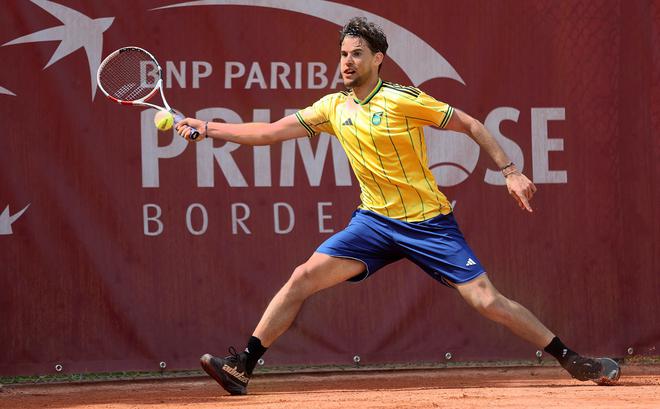When Dominic Thiem won the 2020 US Open, tennis’ Wheel of Life had seemingly course-corrected. After more than three years’ utter domination by the legendary, but ageing, trio of Roger Federer, Rafael Nadal and Novak Djokovic — they had swept the previous 13 Majors — it appeared that the old had given way to the new. Before Thiem, one had to travel back six long years for a first-time Slam winner – Marin Cilic at the 2014 US Open.
It didn’t matter that the tournament was wrecked by Covid and was played in the soul-shattering atmosphere of a bio-bubble. An injured Federer had by then shut down his season and Nadal didn’t take the trouble to cross the Atlantic amidst severe travel restrictions. Djokovic entered New York, but was disqualified for accidentally striking a lineswoman with the ball during his fourth-round match.
This meant the competition provided the first glimpse of how men’s tennis could shape up in the absence of the ‘Big Three’. Thiem, ranked No. 3 in the world, led the mid-card, also comprising Alexander Zverev (the vanquished finalist), Daniil Medvedev and Stefanos Tsitsipas, and was the first to break through. That he had already reached three Grand Slam finals (2018 & 2019 French Open, 2020 Australian Open) and beaten the top stars consistently made his ascent unsurprising.
A struggle
Two years and eight months since that victorious September Sunday, Thiem is a shadow of his former self. He hasn’t added a single Tour-level trophy to his collection, has struggled with injuries, lost form and motivation, and plummeted in the rankings.
The nadir came in June 2022 when he suffered seven straight first-round losses and slipped to as low as No. 352.
The Austrian, who will turn 30 this September, has inched his way back into the top-100, but the tennis world of today is drastically different to the one he once inhabited. Not one but two other players — Medvedev and Carlos Alcaraz — have won their first Majors and subsequently scaled the pinnacle of the ATP rankings. The likes of Jannik Sinner are waiting to stake claim, making Thiem’s climb back to the top arduous.
Thiem’s fall has been astonishing to say the least. Injuries in this era of tennis are par for the course, but Thiem’s style of play, built on explosive athleticism and physicality, involving whipped strokes loaded with top-spin, puts immense pressure on his legs, wrists and forearms.

In the last three years, he has hurt both his knees, damaged his right wrist (June 2021) that put him out for nine months and suffered an abdominal muscle injury (2023 Australian Open). In March 2022, just after his comeback, he tested positive for COVID-19, sapping whatever little energy was left.
Ahead of the Indian Wells Masters this March, Tennis Data Innovations quantified this decline, Thiem’s average forehand speed had reduced from 77.6 mph before the wrist trouble to 74.8, average top-spin from 2978 rpm to 2674 and top-spin use from 93% to 89%.
Emptiness
Thiem has also struggled for motivation. In this, he is not alone. American legend Andre Agassi has spoken eloquently about a certain “emptiness” he felt after having become World No. 1.
Djokovic experienced something similar after the 2016 Roland-Garros victory, his first on the red dirt, which made him the first men’s player since Rod Laver to hold all four Grand Slam titles at the same time. The Serb needed more than two years to return from the wilderness.
“When you spend your whole life chasing your big goal, subordinating everything to it and then achieving it, things are no longer the same for a while,” Thiem told Austrian daily Der Standard in April 2021.
“I spent 15 years chasing the big goal… without looking to the left or to the right. I achieved it under strange circumstances, [but] in a way, some things have fallen by the wayside.”
In the second half of 2022, Thiem finally looked like he had turned the corner, only to fall back into the rut this season. Where he improved to finish with a 18-14 win-loss record last campaign, he lost nine of his first 10 matches in 2023. Only at the Estoril Open (Portugal) did he manage to win back-to-back matches for the first time since Antwerp last October.
But the 29-year-old remains upbeat. He may already be thinking about life beyond tennis, but the intent to reclaim his place in the upper echelons of the sport is visible.
This summer on clay — a surface on which he has won 10 of his 17 Tour-level crowns — he has shown more than a flicker of life and appears set to improve on his two straight first-round defeats at Roland-Garros.
At the Monte Carlo Masters, he beat the old warhorse Richard Gasquet and at the Madrid Masters, he went toe-to-toe with Tsitsipas before losing in a final set tie-break. Prior to that, in the opening-round win over Kyle Edmund, his average forehand speed and spin showed significant improvement (78 mph and 3099 rpm respectively).
“The shots are getting way better,” Thiem said in Monte Carlo. “I have the feeling that I can go full power with the wrist. There is no restriction. The goal is now to put everything together, because there is way more to tennis than to just be able to hit full.”







